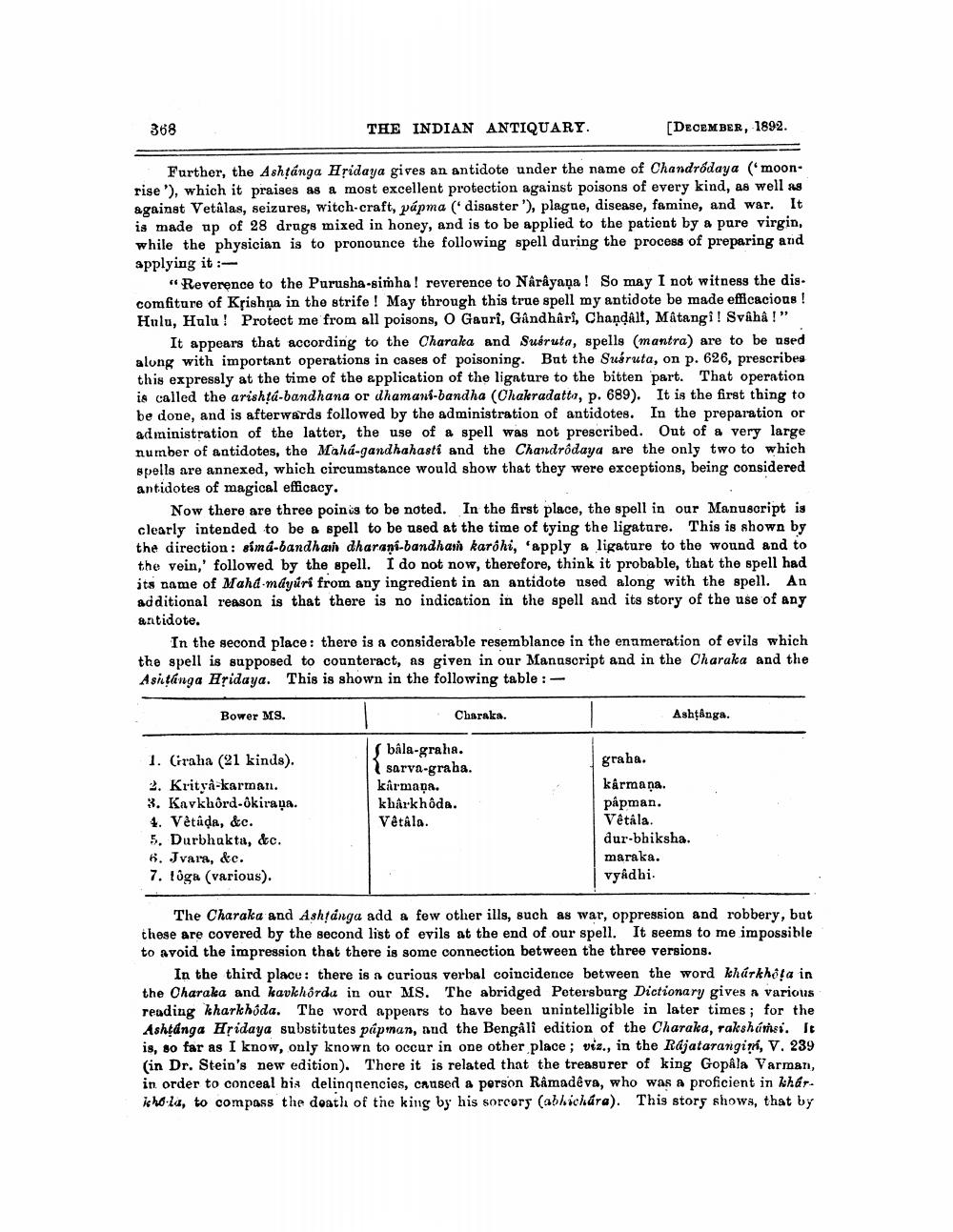________________
368
THE INDIAN ANTIQUARY.
[DECEMBER, 1892.
Further, the Ashtanga Hridaya gives an antidote under the name of Chandrådaya ("moonrise '), which it praises as a most excellent protection against poisons of every kind, as well as against Vetâlas, seizures, witch-craft, pápma (disaster'), plague, disease, famine, and war. It is made up of 28 drugs mixed in honey, and is to be applied to the patient by a pure virgin, while the physician is to pronounce the following spell during the process of preparing and applying it :
"Reverence to the Purusha-simha! reverence to Narayaņa! So may I not witness the discomfiture of Krishna in the strife! May through this true spell my antidote be made efficacions ! Hulu, Hulu! Protect me from all poisons, O Gauri, Gandhari, Chandalt, Mâtangi! Svâhâ !”
It appears that according to the Charaka and Suéruta, spells (mantra) are to be used along with important operations in cases of poisoning. But the Susruta, on p. 626, prescribes this expressly at the time of the application of the ligature to the bitten part. That operation is called the arishta-bandhana or dhamani-bandha (Chakradatto, p. 689). It is the first thing to be done, and is afterwards followed by the administration of antidotes. In the preparation or administration of the latter, the use of a spell was not prescribed. Out of a very large number of antidotes, the Maha-gandhahasti and the Chandrôdaya are the only two to which spells are annexed, which circumstance would show that they were exceptions, being considered antidotes of magical efficacy.
Now there are three poin is to be noted. In the first place, the spell in our Manuscript is clearly intended to be a spell to be used at the time of tying the ligature. This is shown by the direction : simá-bandhari dharani-bandhan karóhi, 'apply a ligature to the wound and to the vein,' followed by the spell. I do not now, therefore, think it probable, that the spell had its name of Mahd mdyúri from any ingredient in an antidote used along with the spell. An additional reason is that there is no indication in the spell and its story of the use of any antidote.
In the second place: there is a considerable resemblance in the enumeration of evils which the spell is supposed to counteract, as given in our Manuscript and in the Charaka and the Ashtanga Hridaya. This is shown in the following table :
Bower MS.
Charaka.
Ashtanga.
1. Graha (21 kinds). 2. Kritya-karman. 3. Kavkhôrd-okiraņa. 4. Vetada, đe. 5. Durbhakta, &c. 6. Jvara, &c. 7. löga (various).
bala-graha.
sarva-graba. karmaņa. kharkhoda. Vêtala.
graha. kármaņa. påpman. Vêtâla. dur-bhiksha. maraka. vyâdhi
The Charaka and Ashtanga add a few other ills, such as war, oppression and robbery, but these are covered by the second list of evils at the end of our spell. It seems to me impossible to avoid the impression that there is some connection between the three versions.
In the third place: there is a curious verbal coincidence between the word khárkhópa in the Charala and kavkhôrdu in our MS. The abridged Petersburg Dictionary gives a various reading Kharkhida. The word appears to have been unintelligible in later times; for the Ashtanga Hridaya substitutes pápman, and the Bengali edition of the Charaka, rakshámes. It is, so far as I know, only known to occur in one other place; viz., in the Rajatarangimi, V. 239 (in Dr. Stein's new edition). There it is related that the treasurer of king Gopala Varman, in order to conceal his delinquencies, caused a person Råmadêva, who was a proficient in Khár. ichola, to compass the death of the king by his sorcery (abhichára). This story shows, that by




